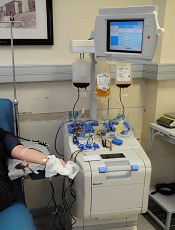
Photo by ec-jpr
ANAHEIM, CA—A newer, more streamlined apheresis system yields more CD34+ cells from stem cell transplant donors than a previous system, according to a new study.
Researchers used both tools—the COBE Spectra Apheresis System and the Spectra Optia Apheresis System—to collect mononuclear cells (MNCs) from healthy donors and found the collection efficiency and yield was superior with the Spectra Optia.
There were no unanticipated or serious adverse events with either system, and the frequency of treatment-emergent adverse events did not differ according to the system used.
Jose A. Cancelas, MD, PhD, of Hoxworth Blood Center in Cincinnati, Ohio, presented the results of this research at the 2015 AABB Annual Meeting (abstract S21-020A). The study was supported by Terumo BCT, the company that makes both systems.
The COBE Spectra Apheresis System collects MNCs via single-step processing and separation. It has been the gold standard for hematopoietic stem and progenitor cell collection since 1987, Dr Cancelas noted.
The newer Spectra Optia Apheresis System uses optical sensors for tracking the separation process and real-time electronic adjustment of plasma pump velocity (automatic interface management). A single-step, continuous MNC collection (CMNC) protocol, which was recently approved for use with this system in the US, is intended to increase automation and MNC collection reproducibility.
To compare the 2 systems, Dr Cancelas and his colleagues conducted a prospective, randomized, crossover study of 22 healthy donors. They had a mean age of 35 and a mean body mass index of 34.2 kg/m2.
The donors underwent 2 MNC collections, first with one apheresis system and then the other. Both times, the donors underwent apheresis on Days 5 and 6 after standard MNC mobilization with granulocyte colony-stimulating factor (G-CSF at 10 mg/kg/day) through Day 5. After the first collection, there was a 2-week washout period.
The study’s primary endpoint was CD34+ cell collection efficiency, which was the percentage of cells collected using the averaged pre/post-collection cell counts as the denominator (CE1). The secondary endpoint was also CD34+ cell collection efficiency, but this was the percentage of cells collected using only the pre-collection cell count as a denominator (CE2).
The researchers also assessed the CD34+ cell yield (CD34+ cells/kg), MNC product contamination/purity, procedure time, product volume, the need for operator involvement, and safety.
Results
All collections processed 1.5 times the total blood volume, and the procedures took nearly 2.5 hours, with no real time difference between the 2 systems.
The average flow rates were 66 mL/minute with the Spectra Optia and 68 mL/minute with COBE Spectra. Product volumes were 143 mL and 139 mL, respectively.
The Optia proved significantly superior to the COBE system with regard to CE1, CE2, and the CD34+ yield.
The mean CD34+ CE1 was 85% with Optia and 66.2% with COBE (P<0.001). The mean CD34+ CE2 was 62% and 48.4%, respectively (P<0.001). And the mean CD34+ yield (cells/kg) was 4.5 and 3.58, respectively (P=0.001).
In addition, granulocyte contamination was lower with the Optia system than the COBE system. The mean granulocyte yield was 7.7 x109 and 10.6 x109 granulocytes per unit, respectively (P=0.022).
However, red blood cell and platelet contaminations were similar between the systems. The mean red blood cell volume was 7.4 mL with Optia and 7.0 mL with COBE (P=0.660). And the mean platelet yield was 4.3 x1011 and 4.6 x1011, respectively (P=0.081).
Overall, there was no significant difference between the Optia and COBE systems in the need for operator adjustments, although there was a trend toward fewer adjustments with the Optia system. It required a median of 5.5 adjustments (range, 0-12), and the COBE system required a median of 6.5 adjustments (range, 1-14).
Dr Cancelas said the frequency of treatment-emergent adverse events did not differ according to the system used. And there were no unanticipated or serious adverse events.
The most frequently reported pre-collection treatment-emergent adverse events were back pain (n=10, 44%), bone pain (n=9, 39%), and fatigue (n=5, 22%).
“These results demonstrate that the Optia CMNC procedure is a safe and efficient means of collecting CD34+ cells in G-CSF mobilized donors,” Dr Cancelas said.
“The Optia collection efficiencies for CD34+ cells were significantly superior to the COBE . . . . And the Optia with automatic interface management system represents a technological advance in our ability to collect CD34+ cells.”


